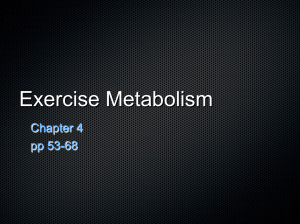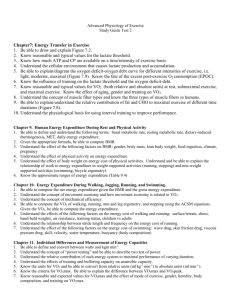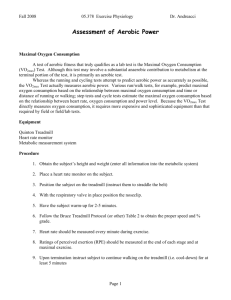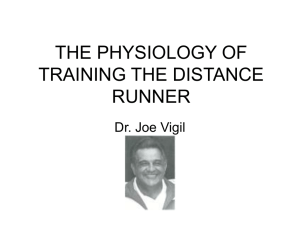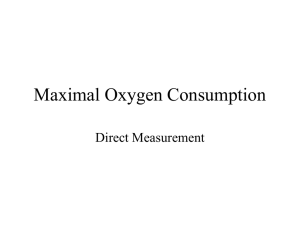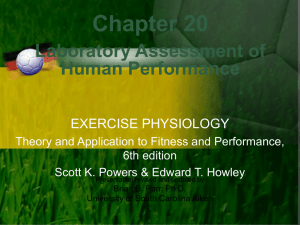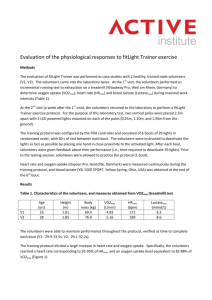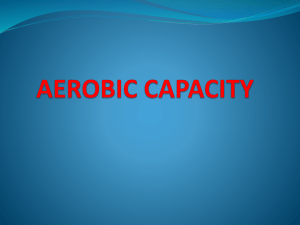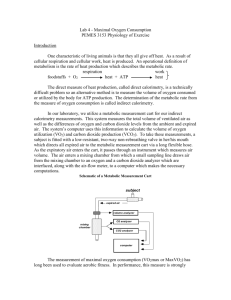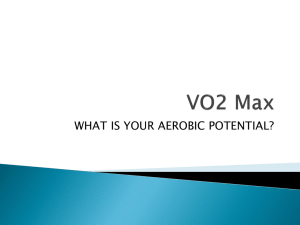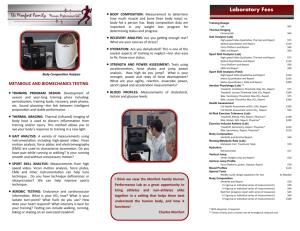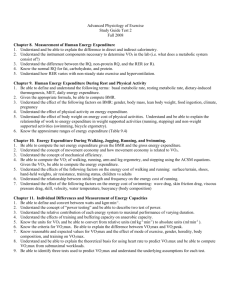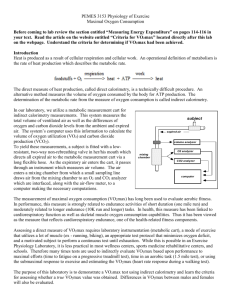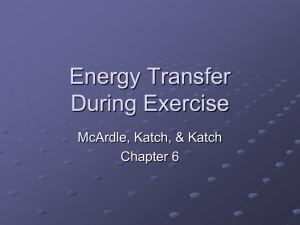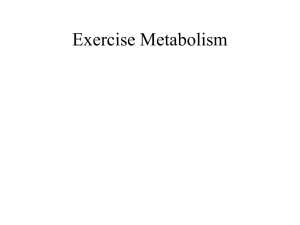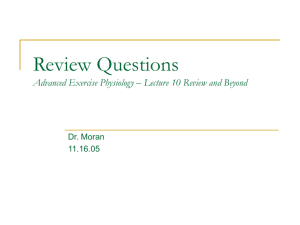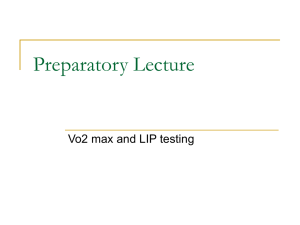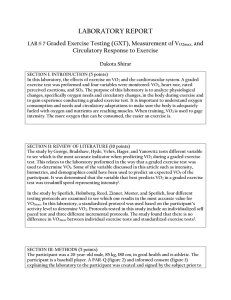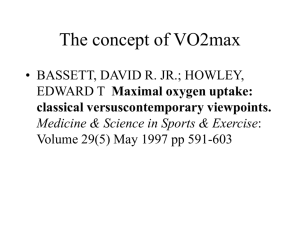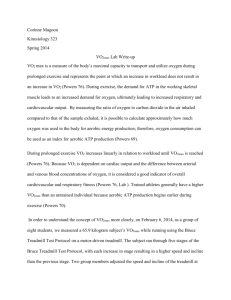Lab 3 - Tarleton State University
advertisement
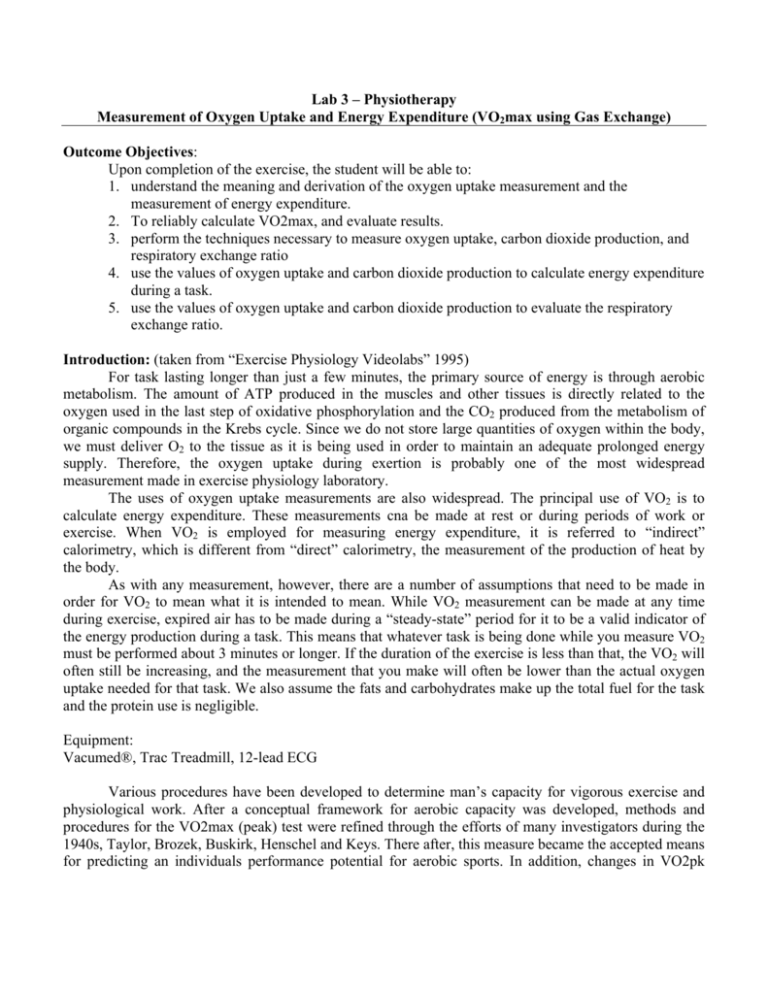
Lab 3 – Physiotherapy Measurement of Oxygen Uptake and Energy Expenditure (VO2max using Gas Exchange) Outcome Objectives: Upon completion of the exercise, the student will be able to: 1. understand the meaning and derivation of the oxygen uptake measurement and the measurement of energy expenditure. 2. To reliably calculate VO2max, and evaluate results. 3. perform the techniques necessary to measure oxygen uptake, carbon dioxide production, and respiratory exchange ratio 4. use the values of oxygen uptake and carbon dioxide production to calculate energy expenditure during a task. 5. use the values of oxygen uptake and carbon dioxide production to evaluate the respiratory exchange ratio. Introduction: (taken from “Exercise Physiology Videolabs” 1995) For task lasting longer than just a few minutes, the primary source of energy is through aerobic metabolism. The amount of ATP produced in the muscles and other tissues is directly related to the oxygen used in the last step of oxidative phosphorylation and the CO2 produced from the metabolism of organic compounds in the Krebs cycle. Since we do not store large quantities of oxygen within the body, we must deliver O2 to the tissue as it is being used in order to maintain an adequate prolonged energy supply. Therefore, the oxygen uptake during exertion is probably one of the most widespread measurement made in exercise physiology laboratory. The uses of oxygen uptake measurements are also widespread. The principal use of VO2 is to calculate energy expenditure. These measurements cna be made at rest or during periods of work or exercise. When VO2 is employed for measuring energy expenditure, it is referred to “indirect” calorimetry, which is different from “direct” calorimetry, the measurement of the production of heat by the body. As with any measurement, however, there are a number of assumptions that need to be made in order for VO2 to mean what it is intended to mean. While VO2 measurement can be made at any time during exercise, expired air has to be made during a “steady-state” period for it to be a valid indicator of the energy production during a task. This means that whatever task is being done while you measure VO2 must be performed about 3 minutes or longer. If the duration of the exercise is less than that, the VO2 will often still be increasing, and the measurement that you make will often be lower than the actual oxygen uptake needed for that task. We also assume the fats and carbohydrates make up the total fuel for the task and the protein use is negligible. Equipment: Vacumed®, Trac Treadmill, 12-lead ECG Various procedures have been developed to determine man’s capacity for vigorous exercise and physiological work. After a conceptual framework for aerobic capacity was developed, methods and procedures for the VO2max (peak) test were refined through the efforts of many investigators during the 1940s, Taylor, Brozek, Buskirk, Henschel and Keys. There after, this measure became the accepted means for predicting an individuals performance potential for aerobic sports. In addition, changes in VO2pk observed in conjunction with training or bed rest investigations became the “gold standard” by which the effect of these investigations on “physical fitness” were judged. Measuring the Lactate Threshold Blood Lactic Acid Threshold. Investigators have developed specific exercise protocols to study the dynamics of blood lactic acid (HLa) response during exercise. It has become popular to describe the socalled Lactate Threshold as the exercise level that causes an individuals’ blood lactic acid level increase to the range of 2-4 mmol/L. Some investigators have distinguished between exercise or work intensities that raise blood lactic acid level to 2 mmol/L and the intensity that raises the level to 4 mmol/L. In this lab, we will conduct an exercise test on a treadmill for purposes of being able to detect the onset of blood lactate accumulation or OBLA. OBLA or Tlac is defined as the first point during incremental exercise that lactate concentration rises more than 2 mM. The test consists of successive stages of exercise on a treadmill, bicycle ergometer, swimming flume, rowing machine etc. Initially the exercise intensity is about 50- 60% of the VO2max. Each stage generally lasts about 4 to 5 minutes. Near the end of each stage, heart rate is recorded, oxygen consumption is measured, and a sample of blood is withdrawn, using a needle prick of the finger or earlobe. Using special instrumentation, blood lactate concentration can be determined during the test. After these measurements, the workload is increased and the steps repeated. Through a 6 stage test, we would expect to achieve a distribution of intensities that are below, at , and above the intensity of OBLA or the lactate threshold. The data from a test would generally look similar to the example below. Interpreting the Data For purposes of interpretation, let's say that the athlete above had a maximal heart rate of 182, and a VO2max or 61 ml/min/kg. These were also determined using a bicycle test. So they are good values for comparison. Looking at the green dots, we see that blood lactate concentration does not begin to increase until during the 4th workload, from a concentration of about 1 mM to 2.5 mM. This is the break point. The subjects VO2 was 45 ml/min/kg at this point. So we determine that his LT occurs at 45/61 or about 74% of VO2max. If we look at the heart rate at this point, it is 158. Now we have a heart rate at lactate threshold. 158 = about 85% of his max heart rate. This is useful for the athlete. When he is cycling, he can judge his training intensities based on this important value. If he is competing in a time trial, this would approximate his racing heart rate for the hour long event. A VO2max exercise test specifically refers to an exercise test usually conducted on a cycle ergometer or treadmill lasting approximately 8 to 12 minutes in length in which an individual must exercise to maximal point. In a healthy population, certain end-points are used to evaluate whether or not a subject actually reaches volitional fatigue or max. Those include the following: Physiological and subjective variables (end-points): – Plateau in oxygen consumption – Heart rate (age predicted maximum) – Lactate production (>8 mmol) – Rating of Perceived Exertion (RPE) – RER > 1.15 For this lab, you will be measuring gas exchange variables in your subject and evaluating whether or not they actually reach a TRUE VO2max. You will also be evaluating where ventilatory threshold, and how to match that up with HR, so that the athlete might use this for training purposes. Finally, you will provide a fitness ranking using the ACSM guidelines. Procedures: Screening: Have your subject complete a PAR-Q and an Informed Consent before collecting data. Resting: 1. Calibrate specified equipment to factory standards. 2. Hook client up to heart rate monitor (or ECG) as appropriate 3. Fit the breathing apparatus to the subject and have the individual rest in a sitting position for 4 minutes. Record heart rate for each minute. Exercise: 1. Fit the breathing apparatus to the subject, affix the nosepiece, and have the individual rest in a standing position. 2. After 3 or 4 minutes of data is collected at rest, the subject should perform an incremental exercise test to volitional fatigue. 3. Have the subject find a comfortable walking or jogging speed. The subject should rate the exercise at approximately 10-11 on the RPE scale. 4. Increase the grade of the treadmill by 1 % every minute, and the speed by .5 mph every 4th minute. 5. Record HR every minute and RPE every 3 minutes. 6. Have the subject continue exercising until they wish to stop. Results: Record results in data collection forms provided for your lab group. Store the data during the experiment for lab write up and discussion in class. After calculating the gas exchange responses, present the results in tabular or graphic form using the attached graphs. Consult journal articles to see various ways that may be used to present date in meaningful ways. For example VO2 and VCO2 may be plotted on the y-axis of a graph against time (minute) and measurement conditions on the x-axis. Report: 1. For this lab, prepare your report using the exercise testing sheet and graphic layouts provided. Prepare your report by writing your purpose statement and construct whatever tables and graphs you can do to present the findings in the best way possible to meet your stated objectives. Try to combine the results from the testing you do in the lab to provide a comprehensive view of your subjects VO2 and gas exchange responses. 2. Evaluate whether or not your partner reached a true VO2max by answering the questions stated above. 3. Evaluate the fitness ranking for your partner.
